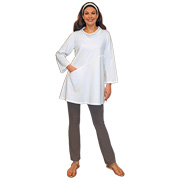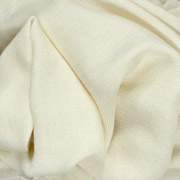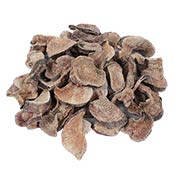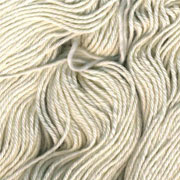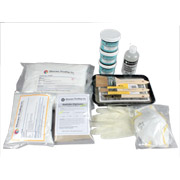Batik is a wax resist fiber art. Hot wax is applied to fabric in a design. The wax serves as a resist, preventing the dye from reaching the fabric where it was applied. This technique can be applied in layers with different colors.
The Batik effect is unique in that the wax cracks during handling, either intentionally or not. In each dye bath, the cracks in the wax allow the dye to reach the fabric creating the unique batik effect . Batik can be done on cottons, silks and other natural fabrics. "Faux" batik employs other types of resists, particularly water soluble ones, that are easier to remove than wax, but never quite achieve the same beautiful crackling. Dharma Procion MX Fiber Reactive Dyes are the dye of choice for batik on cotton because they are used with cold water.

Artwork by Sue C. Duda
Batik masters employ the process of repeated waxing and tub dyeing to achieve their final result. This method involves an understanding of color mixing and overdyeing, as each layer of dye is applied over the last, producing a new color. After many different applications, the background tends towards dark brown, black or grey. The waxed areas remain the lighter shades produced by each individual dye application and combinations thereof.
Waxing and Immersion Method
- First, pre-wash your fabric, ideally with a professional dyer's product called Kieralon . This removes most oils, sizings, and pre-shrinks the fabric. It is best to use "PFD" (Prepared For Dyeing) fabric or "RTD" (Ready To Dye) fabric that is for sure not treated with finishes like permanent press, which will keep the dye from attaching. Iron out any wrinkles.
- Stretch the fabric on a Frame or Hoop that will keep the fabric flat and horizontal.
- Use pre-mixed Batik Wax, or your own combinations of Beeswax or Sticky Wax and Paraffin waxes. The more Paraffin, the more the wax will crackle. By themselves, Beeswax and Sticky wax don't crackle and Paraffin wax crackles too much. The wax mixture is then melted in a double boiler, electric wax pot, or old electric frying pan set at about 220-240 (CAREFUL! If you heat the wax over it's flash point it can give off toxic smoke or burst into flames!)
- Apply the wax, using tools like the Tjanting or the Deluxe Tjanting for outlining, and natural fiber brushes to fill in areas. Wax designs can be repeatedly stamped onto the fabric with metal stamps called "chops", like they do in Indonesia, but they have to be symmetrical so they can be lined up and stamped in exactly the same spot on the reverse side of the fabric so that no dye will penetrate. When applying wax, no matter what method you are using, regulate the temperature so that it penetrates the fabric, not so cool that it just turns yellowish and sits on top, and not so hot that all your lines spread out too much. The wax should have a clear appearance, indicating it has penetrated to the other side. To make things easier, use an Electric Tjanting which can be regulated with a rheostat, so it maintains the wax at the correct temperature.
- Mix up Dharma Procion MX Fiber Reactive Dye as instructed for tub dyeing.
- Tub dye the fabric, first using the lightest color that will be on the piece and will mix well with successive colors, such as yellow, then the next dye bath could be turquoise, which would actually mix with the yellow to dye the fabric green in all the areas where the yellow was not waxed over. Remember - after Soda Ash has been added to the dyebath, don't leave your waxed fabric in for more than 30 minutes more, as soda ash eats away the wax eventually, exposing areas to unwanted dye.
- Rinse and gently hand wash the fabric in Kieralon and allow to dry. Use cool water so as not to melt your wax!
- Repeats steps 2-6 for each color you plan for your batik, waxing areas after each dyebath that you want to remain that most recent color, and re-waxing any areas that look eroded. Tub dye your darkest areas last. The final mix of colors at the end will be a brown, grey or black, combining all of the colors used on the piece. Hint - Do a test strip first with all of the colors you are planning to use to make sure they are combining like you want.
Wax removal can be accomplished in one of four ways:
- Take it to the dry cleaners and let them get it out. (Some won't do it for you)
- Boil the wax out. This is the oldest form of batik wax removal. Choose a pot that will comfortably hold your fabric and fill with water and a dash of Kieralon to get the wax and any remaining excess dye away from the fabric. Bring to a simmer/boil and add fabric. Use something to stir the fabric around in the boiling water and keep it submerged. After a few minutes, the wax will boil out of the fabric and float to the top. When the wax seems completely removed from the fabric, remove from heat and allow the water to cool. Be sure that the fabric sits on the bottom of the pan, avoiding the floating wax residue. Allow to cool and peel the hardened wax off the surface and remove the fabric. In Indonesia, people skim the hot melted wax off the boiling vats with big perforated ladles. Whatever works!
- Iron the wax out. This is also a traditional wax removal process. The fabric is sandwiched between layers of absorbent paper such as Newsprint and heat is applied by iron, to melt the wax out. This process often leaves a wax residue (looks like a grease spot) that is very difficult to remove, so it is not recommended.
- Use hot tap water. Hang the finished piece on a line. Attach a hose to a hot water spigot, turn your water heater up all the way and run hot water over the piece to melt the wax off. A collection tub should be placed under the fabric to catch the wax and water.




